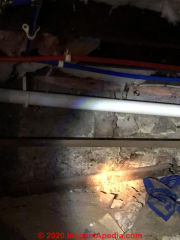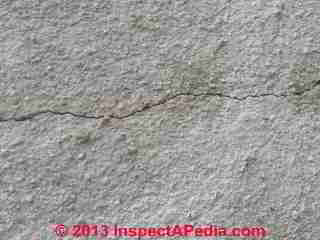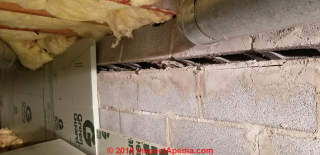 Horizontal Foundation Crack FAQs
Horizontal Foundation Crack FAQs
Examples of foundation wall horizontal crack damage
- POST a QUESTION or COMMENT about the evaluation of horizontal cracking in a foundation wall
Horizontal masonry wall or foundation crack damage assessment FAQs.
Q&A on how to recognize, evaluate, diagnose & repair horizontal foundation cracks and signs of foundation damage.
In this article series foundation cracks and movement are discussed by type and location of foundation cracks, vertical foundation cracks, horizontal cracks, and diagonal foundation cracks, and shrinkage cracking.
InspectAPedia tolerates no conflicts of interest. We have no relationship with advertisers, products, or services discussed at this website.
- Daniel Friedman, Publisher/Editor/Author - See WHO ARE WE?
Q&A on Horizontal Crack Damage to Foundation Walls
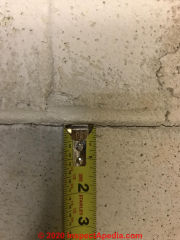 Foundation cracks, which are signs of foundation damage, can mean very different things
depending on the material from which a foundation is made, the location, size, and shape of the foundation crack, and
other site observations.
Foundation cracks, which are signs of foundation damage, can mean very different things
depending on the material from which a foundation is made, the location, size, and shape of the foundation crack, and
other site observations.
Watch out: severely-buckled foundation walls, particularly those constructed of un-reinforced concrete block, brick, or stone, are at risk of collapse.
Such collapses can occur suddenly and precipitously even when the foundation crack or damage has been visible for some time. The result can be a dangerous building collapse causing property loss, injury, even death.
On 2020-08-10 - by (mod) -
Indeed your photo (shown just above] looks like a pressure-related horozntal mortar joint crack in a block wall. What's going on outside this wall?
If the wall is not leaning nor bulged more than a fraction of an inch AND if this is not a new crack, repair is probably less urgent.
On 2020-07-27 by Al
Hello! I noticed this cracks on my foundation wall in a basement
. I didn’t see a bulge but I didn’t measure using a plumb line. Visually I can’t see anything.
On 2020-06-25 by Shawna
Ok, thank you. Will do.
On 2020-06-25 - by (mod) -
Clean loose debris,
then see options & how-to articles starting at
CONCRETE SLAB CRACK REPAIR where, in that article series, we list common concrete repair and patching products
don't hesitate to ask follow-up questions; that helps us both.
On 2020-06-25 by Shawna
thank you. Yes, I agree it’s a mess back there. Do you have any recommendations on what to use for patching the exterior?
On 2020-06-25 - by (mod) -
Good going on peeking into a hard-to-access area, for even this very limited view.
What a terrible no-access crawl area; let's hope there are no plumbing leaks nor burst pipes.
I'd patch from the exterior and be sure to keep roof drainage and surface runoff away from the foundation.
On 2020-06-25 by Shawna
Exterior foundation beneath stairs. Lots of water from overflowing gutters hit the stairs, from what we’ve seen since owning.
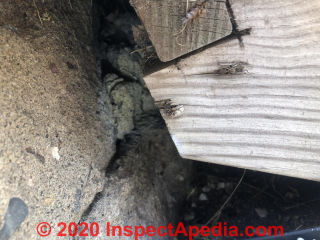
On 2020-06-25 by Shawna
I took a few pictures but it looks like I can only post one at a time, so I will post more after this comment.
This photo is of the other side of the foundation. This crawl space was left in rough shape, they left debris, old concrete, etc under there. It looks misshapen on the other side of this exterior crack, as if they tried to repair it sloppily. That’s how it appears.
The original house was built in 1880. This part of the foundation is an addition, I believe added somewhere around the 80s or 90s.
We are located in East Providence, R.I. The original 1880 foundation is in pretty good shape. We had the interior repointed and no issues were reported. I cannot visibly see any bulging and there are no significant cracks that I can see.
Around the exterior, there isn’t much damage. We have one section of the original foundation that leaks water into the basement during a heavy rain. We’re planning on addressing this at some point.
The exterior crack that I showed you, is right next to wooden stairs that were built over decrepit concrete stairs. The interior part of the foundation behind those stairs is where it looks misshapen. The rest of the foundation looks solid and flat.
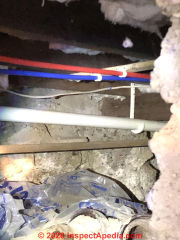
On 2020-06-24 - by (mod) -
If you or someone can get any view at all that'll help.
If not we're left either relying on indirect clues like signs of movement in the building or cutting a small opening to permit inspection.
What are the country and city of location?
What is the age of the home?
Look around the exterior for other signs of damage.
inside are there cracks, or leaning bulging walls or ceilings or floors?
On 2020-06-24 by Anonymous
I think there is a crawl space behind this crack. It’s hard to get to but I can try to get under and see if I can take some pictures of it. I just found out that next to this crack are a pair of old concrete stairs that they built wooden stairs over. They look pretty decrepit but I cannot see them fully without removing the stairs. I will get behind the crack and post pictures.
On 2020-06-23 - by (mod) -
Shawna
Is there a basement or crawl space that gives access to the foundation in this area and that would let us see conditions below that horizontal crack?
we want to know the extent of damage and whether or not there are signs of building movement or more-extensive damage to the structure.
I suspect water and frost and maybe earth pressure are damaging the foundation in the location of your photo - pushing it inwards, but I can't see enough to have an opinion about just how much damage has occurred.
On 2020-06-23 by Shawna
I have a T-shaped crack in the foundation of my house. It is above ground and there was significant drainage issues with the gutters above, resulting in water flowing out against this area. We have fixed the gutter issue but not sure if this crack indicates a more serious problem, like a structural issue.

Reader Question: Is this horizontal crack serious? Hairline horizontal crack evaluation request
 My house is 20 years old and sits on a slope. I found a horizontal crack last weekend when I was out in the back yard. Normally I stay indoors and don’t go out to back yard.
My house is 20 years old and sits on a slope. I found a horizontal crack last weekend when I was out in the back yard. Normally I stay indoors and don’t go out to back yard.
I can’t say when the crack started. I think it is probably recent because the horizontal dark line is obvious. I start looking on internet. I love your website. A lot of info and very knowledgeable. Therefore I wonder if you can help giving some advices. I am scared right now.
Here are some details. The first picture was taken from the backyard.
You can see the back of the house sits on a big wall of concrete. Actually, the whole house sits on concrete. The concrete thickness in the front of house is thin, and it gradually become thicker.
The concrete wall is about 10 feet high in the back of the house as the picture shown.
There is a dark color horizontal crack. The dark color looks like caused by the moisture coming out of the crack. The crack starts from half way on one side of the house, runs across the back, and ends around the half way of the other side of house.
The second picture shows the close look of the crack. It is not big. I don’t know if it is hardline wide.
Could you please give me some opinions? I already scheduled visits with a few foundation repair companies. I hope you can provide me an independent assessment on how to fix it.
Reply
A competent onsite inspection by an expert usually finds additional clues that would permit a more accurate, complete, and authoritative answer than we can give by email alone.
You will find additional depth and detail in articles at our website. And I'm in the dark about your comments about varyijng concrete thickness.
That said I offer these comments:
It's not clear if the cracked wall is reinforced poured concrete (lower risk) or a cement parge-coated concrete block foundation wall (higher risk).
It's also not clear from the photo the extent of wall movement and bending - factors that along with rate of change, site conditions, and building construction methods would define the risks involved.
What I can see in your masonry wall crack photos includes:
- what looks like a brick veneer wall built atop a masonry wall that is either concrete or concrete block, with
- a horizontal crack less than 1/4" wide, extending along a portion of the foundation wall
- what looks like water stains down the building wall and along the pathway of the horizontal crack - water and frost, or if reinforced concrete, rusting steel re-bar or mesh could be factors in this cracking
- a downspout that spills by the foundation wall
- flat, poorly-graded site that traps water against the foundation - possible sources of footing settlement or movement, but if the footing were moving I'd be surprised if the crack were so localized in just a portion of the width of the wall
- and in close-up to me the crack looks "recent" in that its edges don't look weathered and though the wall has been painted, there is no paint inside the crack
A competent assessment requires an onsite inspection by an expert in foundation repair - perhaps an experienced mason or a structural or civil engineer who has specific experience with residential foundation wall troubleshooting and repairs.
An expert will look at the size, pattern, location, of the crack, the extent of wall bending (more than an inch is likely to be a more urgent concern), crack and movement history, site factors, and similar items in forming an opinion.
I realize that we don't want to waste an expert's time and our own money on an inspection and analysis that may not be necessary, and also that lots of "experts" find it safer for themselves to spend more of your money by calling for measures that may not really be appropraite.
In general, I would expet (OPINION) that an experienced building inspector, home inspector, or one of the foundation experts I listed above would, on seeing a wall like the one in your photos, figure that if the wall is close to perfectly vertical and there is no sign of rapid ongoing movement, a hairline crack is low enough risk that you could reasonably hold off on heroics and watch the wall and crack for signs of further movement.
It would make sense also to keep surface runoff and roof spillage (the downspout in your photo and the gutter above if it's clogged) away from the building foundation wall. It might make sense to include in your evaluation the condition of the brick veneer as well - as it looks as if water has run down the building wall.
Take a look at both
Reader Follow-Up: more details about the fine horizontal crack found in the wall photographed above
I finally found pictures from last year showing the horizontal line was already there. So this is not new. Yesterday two foundation repair companies came. Both of them didn’t see anything wrong inside and outside.
There is no crack inside. Floor is almost flat using test tool. Drainage is ok. Foundation is fine.
They can’t tell what was causing this horizontal crack line. Both of them guessed this crack might be caused by cold pouring joint.
The hairline crack is a straight horizontal line starts from one side of the house, all across the back, and to the other side of house. They offered a few tips to direct water away from the house. They both told me nothing to worry about. Just keep an eye on it.
They showed me that the concrete is parge coated. I pointed out a spot to one of the inspectors. It looks like some rust is leftover below a small parge coat crack. You can see it in the picture. He said that’s the spot of rebar. He also showed me a few other spots which has rebars inside.
I feel ok now. What should I do next? Do I need to confirm this is really cold pour joint leak(which I don’t know how), or just keep an eye on it?
Sorry for confusing you about the thin/thick. I should say the concrete retaining wall/foundation is shorter near the front of the house, and taller near the back of the house.
Reply: leaks into a concrete, brick, or block masonry wall can cause rust damage cracking or frost cracking
You confirm for sure that this is a poured concrete foundation wall.

I noted earlier that your photo showed what looked like water stains on the exterior wall, also suggesting water was running down the wall.
If a building foundation wall is reinforced poured concrete and if water was leaking into the wall, I noted in my earlier message that water running down a masonry wall where re-bar or reinforcing steel mesh is close to the wall surface or where cracks (say shrinkage cracks or others) admit water into the wall, rust can cause further wall cracking as the pressure exerted by exfoliating rust along steel reinforcement is quite powerful.
This rust damage pattern in foundation walls is more common in brick or block structures (such as shown in our photo at left).
I also note that because steel mesh or re-bar placed in a masonry wall structure are rather straight, water and thus rust damage to the wall, if caused by water intrusion where steel reinforcement has been wet from leaks on or into the wall, tends to cause cracking that is rather straight-line.
Frost cracking that follows water leaks into a masonry wall is more likely to be horizontal in a block or brick wall but might be horizontal in a poured concrete wall if water is entering at a crack where steel reinforcement is close to the wall surface.
Concrete parge coating may have been added to cover up prior rust or water damage to the foundation wall
It is common to see concrete parging coating a concrete block foundation wall. It is less common to see concrete parge coating on the exterior of a poured concrete wall.
One might speculate that if found the parging may have been added on a conctrete wall it might have been done by a prior owner for cosmetic reasons, to cover spalling or rust-caused cracking in the wall surface.
If the prior owners did not realize that wall damage was being caused by roof runoff spilling down the wall surface, even though the wall was parge-coated to cover up old damage that same problem might be expected to recur.
Your onsite inspectors confirmed (by implication in your message not by explicit remark) that there is no significant movement in your wall - leaning, bending, bowing, etc. That in turn means you're not facing an urgent costly structural repair.
- Fix the causes
of roof gutter overflow/spillage that sends roof runoff water down the wall (suggested by your first photo) - Cosmetic repairs to the parging
would be fine and might help keep water out of the crack. Any "patch" type repair such as using masonry caulk or even concrete patch will look just like that - like a patch.
To not see the repair at all you'd need to either patch and then paint the wall surface (which means re-painting from time to time in the future) or re-parge-coat the wall anew - a more costly alternative.
Watch out: To be used properly, this information must be combined with specific on-site observations at the particular building in order to form a reliable opinion about the condition of that building's foundation. Anyone having concern regarding the structural stability, safety, or damage of a building, foundation or other components, should consult a qualified expert.
Question: is this leaning 2+ inch wide block foundation wall horizontal foundation crack serious?
2019/01/23 lashlaruesc said:
Found this seperation in a house we are renting while ours is being built.
This is under a single story living room as the rest of the house is 2 stories and on a basement. My concern is, is this safe for my family to be in?
Reply: Yes. There is risk of foundation collapse, temporary support & repairs are urgently needed
Whipper:
Your photo shows what is almost certainly a very severely-buckled concrete block foundation wall.
Watch out: While nobody can make a complete structural damage assessment from a single photo, the extent of bulge and cracking in your wall is clearly serious and possibly dangerous.
I see there has been a prior superficial attempt at an interior repair - plastering cement across the area now badly buckled and cracked.
From just the photo we don't know the cause though the crack appears to be near the top of a crawl space wall, possibly from traffic, frost, or earth loading.
Watch out: There is risk of a building collapse, though from just the photo alone evidence of the level of risk is incomplete.
If such a collapse occurs occupants of the building could be injured. You should include your photo and your con concerns to an immediate notice to the landlord, orally as well as in writing.
If this were my home I would seek prompt help from a foundation contractor, engineer, builder, who might at the very least add temporary additional support below the floor to gain time to properly diagnose the problem and re-build the foundation wall while correcting the cause of its damage.
See FOUNDATION DAMAGE SEVERITY for a discussion of just how much foundation movement is likely to be a concern.
See also BULGED FOUNDATION REPAIR METHODS for a discussion of the diagnosis of specific crack patterns in masonry
I'd also like to see photos of the building exterior and others of the crawl space to have an extent of the foundation damage.
Question: can I just fill this horizontal crack in the basement wall?
(Dec 2, 2018) Ranjith said:
Found light water leak in the basement and noticed a horizontal crack in the basement, can I just fill this or should I be worried about the expenses? Attached a pic
Reply:
Ran
All i can see is a plastic covered wall and a wet area at floor level.
Watch out: it is not likely that patching the crack on the inside of a cracked and bulged or leaning block foundation wall is going to stop ongoing damage to the structure.
I'd do some further exploring fo find and fix the water source.
...
Continue reading at HORIZONTAL MOVEMENT IN FOUNDATIONS or select a topic from the closely-related articles below, or see the complete ARTICLE INDEX.
Or see these
Recommended Articles
- FOUNDATION FAILURES by MOVEMENT TYPE
- BRICK WALL THERMAL EXPANSION
- BULGED vs. LEANING FOUNDATIONS
- CONTROL JOINT CRACKS in CONCRETE
- DIAGONAL CRACKS in CONCRETE FOUNDATIONS, WALLS
- DIAGONAL CRACKS in BLOCK FOUNDATIONS, WALLS
- EARTHQUAKE DAMAGED FOUNDATIONS
- FOUNDATION MOVEMENT ACTIVE vs. STATIC
- FOUNDATION MOVEMENT COMBINATIONS
- FOUNDATION SETTLEMENT
- FROST HEAVE / EXPANSIVE SOIL
- HORIZONTAL FOUNDATION CRACKS
- HORIZONTAL MOVEMENT
- SETTLEMENT CRACKS in SLABS
- SETTLEMENT vs. FROST HEAVE CRACKS
- SETTLEMENT vs. SHRINKAGE CRACKS
- SHRINKAGE CRACKS in SLABS
- SHRINKAGE GAPS at WALLS
- THERMAL EXPANSION CRACKS
- VERTICAL MOVEMENT IN FOUNDATIONS
- FOUNDATION INSPECTION STANDARDS
Suggested citation for this web page
HORIZONTAL FOUNDATION CRACK SEVERITY FAQs at InspectApedia.com - online encyclopedia of building & environmental inspection, testing, diagnosis, repair, & problem prevention advice.
Or see this
INDEX to RELATED ARTICLES: ARTICLE INDEX to BUILDING STRUCTURES
Or use the SEARCH BOX found below to Ask a Question or Search InspectApedia
Ask a Question or Search InspectApedia
Try the search box just below, or if you prefer, post a question or comment in the Comments box below and we will respond promptly.
Search the InspectApedia website
Note: appearance of your Comment below may be delayed: if your comment contains an image, photograph, web link, or text that looks to the software as if it might be a web link, your posting will appear after it has been approved by a moderator. Apologies for the delay.
Only one image can be added per comment but you can post as many comments, and therefore images, as you like.
You will not receive a notification when a response to your question has been posted.
Please bookmark this page to make it easy for you to check back for our response.
IF above you see "Comment Form is loading comments..." then COMMENT BOX - countable.ca / bawkbox.com IS NOT WORKING.
In any case you are welcome to send an email directly to us at InspectApedia.com at editor@inspectApedia.com
We'll reply to you directly. Please help us help you by noting, in your email, the URL of the InspectApedia page where you wanted to comment.
Citations & References
In addition to any citations in the article above, a full list is available on request.
- In addition to citations & references found in this article, see the research citations given at the end of the related articles found at our suggested
CONTINUE READING or RECOMMENDED ARTICLES.
- Carson, Dunlop & Associates Ltd., 120 Carlton Street Suite 407, Toronto ON M5A 4K2. Tel: (416) 964-9415 1-800-268-7070 Email: info@carsondunlop.com. Alan Carson is a past president of ASHI, the American Society of Home Inspectors.
Thanks to Alan Carson and Bob Dunlop, for permission for InspectAPedia to use text excerpts from The HOME REFERENCE BOOK - the Encyclopedia of Homes and to use illustrations from The ILLUSTRATED HOME .
Carson Dunlop Associates provides extensive home inspection education and report writing material. In gratitude we provide links to tsome Carson Dunlop Associates products and services.


